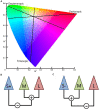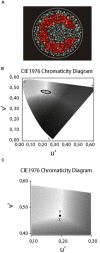Reduced Discrimination in the Tritanopic Confusion Line for Congenital Color Deficiency Adults
- PMID: 27065909
- PMCID: PMC4811883
- DOI: 10.3389/fpsyg.2016.00429
Reduced Discrimination in the Tritanopic Confusion Line for Congenital Color Deficiency Adults
Abstract
In congenital color blindness the red-green discrimination is impaired resulting in an increased confusion between those colors with yellow. Our post-receptoral physiological mechanisms are organized in two pathways for color perception, a red-green (protanopic and deuteranopic) and a blue-yellow (tritanopic). We argue that the discrimination losses in the yellow area in congenital color vision deficiency subjects could generate a subtle loss of discriminability in the tritanopic channel considering discrepancies with yellow perception. We measured color discrimination thresholds for blue and yellow of tritanopic channel in congenital color deficiency subjects. Chromaticity thresholds were measured around a white background (0.1977 u', 0.4689 v' in the CIE 1976) consisting of a blue-white and white-yellow thresholds in a tritanopic color confusion line of 21 congenital colorblindness subjects (mean age = 27.7; SD = 5.6 years; 14 deuteranomalous and 7 protanomalous) and of 82 (mean age = 25.1; SD = 3.7 years) normal color vision subjects. Significant increase in the whole tritanopic axis was found for both deuteranomalous and protanomalous subjects compared to controls for the blue-white (F 2,100 = 18.80; p < 0.0001) and white-yellow (F 2,100 = 22.10; p < 0.0001) thresholds. A Principal Component Analysis (PCA) found a weighting toward to the yellow thresholds induced by deuteranomalous subjects. In conclusion, the discrimination in the tritanopic color confusion axis is significantly reduced in congenital color vision deficiency compared to normal subjects. Since yellow discrimination was impaired the balance of the blue-yellow channels is impaired justifying the increased thresholds found for blue-white discrimination. The weighting toward the yellow region of the color space with the deuteranomalous contributing to that perceptual distortion is discussed in terms of physiological mechanisms.
Keywords: anomalus trichromacy; chromatic thresholds; chromaticity discrimination; color vision; tritanopic color confusion line; visual psychophysics.
Figures





Similar articles
-
Orthogonal relations and color constancy in dichromatic colorblindness.PLoS One. 2014 Sep 11;9(9):e107035. doi: 10.1371/journal.pone.0107035. eCollection 2014. PLoS One. 2014. PMID: 25211128 Free PMC article.
-
Appearance of special colors in deuteranomalous trichromacy.Vision Res. 2021 Aug;185:77-87. doi: 10.1016/j.visres.2021.04.001. Epub 2021 May 4. Vision Res. 2021. PMID: 33962212
-
Perceived color of hallucinations in the Charles Bonnet Syndrome is related to residual color contrast sensitivity.J Neuroophthalmol. 2009 Sep;29(3):192-6. doi: 10.1097/WNO.0b013e3181b1b2bf. J Neuroophthalmol. 2009. PMID: 19726940
-
The simple perfection of quantum correlation in human vision.Prog Neurobiol. 2006 Jan;78(1):38-60. doi: 10.1016/j.pneurobio.2005.11.006. Epub 2005 Dec 27. Prog Neurobiol. 2006. PMID: 16377059 Review.
-
[Genetics of congenital color vision defects. I. Common types of color blindness].Klin Oczna. 1995 Jan-Feb;97(1-2):34-8. Klin Oczna. 1995. PMID: 7637311 Review. Polish.
Cited by
-
Specificity of the chromatic noise influence on the luminance contrast discrimination to the color vision phenotype.Sci Rep. 2020 Oct 21;10(1):17897. doi: 10.1038/s41598-020-74875-3. Sci Rep. 2020. PMID: 33087826 Free PMC article.
-
Age-Related Effects on the Color Discrimination Threshold.Life (Basel). 2025 Jul 5;15(7):1074. doi: 10.3390/life15071074. Life (Basel). 2025. PMID: 40724576 Free PMC article.
-
Reduced eye optical quality contributes to worse chromatic thresholds in aging.Front Integr Neurosci. 2023 Mar 24;17:1129315. doi: 10.3389/fnint.2023.1129315. eCollection 2023. Front Integr Neurosci. 2023. PMID: 37035455 Free PMC article.
References
LinkOut - more resources
Full Text Sources
Other Literature Sources

